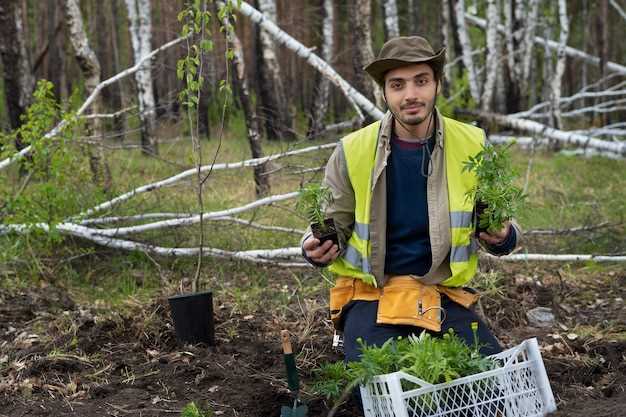
In today’s rapidly evolving world, where our planet is facing unprecedented environmental challenges, it is crucial to explore innovative and sustainable solutions that can effectively mitigate and adapt to the impacts of climate change. One such solution that has gained significant attention is the integration of agroforestry practices into agricultural landscapes. This holistic approach combines the benefits of trees and shrubs with traditional agricultural practices, creating a harmonious and resilient ecosystem.
Agroforestry, often referred to as the art of combining agriculture and forestry, offers a multitude of environmental, social, and economic advantages. By strategically planting trees and shrubs alongside crops, farmers can enhance soil fertility, reduce erosion, and improve water management. These green companions act as natural windbreaks, preventing soil degradation and protecting crops from extreme weather events, such as droughts and floods. Moreover, the diverse root systems of trees and shrubs help sequester carbon dioxide from the atmosphere, mitigating the greenhouse effect and contributing to climate change mitigation.
Furthermore, agroforestry systems provide a habitat for a wide range of biodiversity, including birds, insects, and microorganisms. This biodiversity not only enhances the overall resilience of the ecosystem but also promotes natural pest control, reducing the need for harmful pesticides. Additionally, the presence of trees and shrubs in agricultural landscapes can improve air quality by absorbing pollutants and releasing oxygen, creating a healthier environment for both humans and wildlife.
From a socio-economic perspective, agroforestry offers numerous benefits to farmers and local communities. By diversifying their income sources through the cultivation of timber, fruits, nuts, and other non-timber forest products, farmers can increase their resilience to market fluctuations and improve their livelihoods. Agroforestry systems also promote sustainable land management practices, preserving traditional knowledge and cultural heritage. Moreover, the integration of trees and shrubs in agricultural landscapes can create recreational spaces, attracting tourists and boosting rural economies.
In conclusion, agroforestry represents a promising approach to address the challenges posed by climate change. By harnessing the power of nature and integrating trees and shrubs into agricultural landscapes, we can enhance ecosystem resilience, mitigate greenhouse gas emissions, and improve the well-being of both humans and the environment. Embracing agroforestry practices is not only a sustainable solution but also a testament to our commitment to safeguarding the planet for future generations.
Understanding Agroforestry: A Sustainable Land Use Practice
In this section, we will explore the concept of agroforestry as a sustainable approach to land use. Agroforestry encompasses a holistic and innovative method that combines the cultivation of trees with agricultural practices, creating a harmonious and mutually beneficial relationship between the two. By integrating trees into agricultural landscapes, agroforestry promotes biodiversity, enhances soil fertility, conserves water resources, and provides multiple economic and ecological benefits.
Agroforestry: A Holistic Approach
Agroforestry represents a holistic approach to land management, where the cultivation of trees and crops is integrated into a single system. This approach recognizes the interconnectedness of various elements within an ecosystem and aims to optimize their interactions for sustainable productivity. By diversifying the agricultural landscape with trees, agroforestry enhances ecosystem resilience, mitigates climate-related risks, and contributes to the overall sustainability of land use practices.
Enhancing Biodiversity and Ecosystem Services
One of the key benefits of agroforestry is its ability to enhance biodiversity and provide a range of ecosystem services. The presence of trees in agricultural landscapes creates habitats for a variety of plant and animal species, promoting biodiversity conservation. Additionally, agroforestry systems contribute to carbon sequestration, water regulation, and nutrient cycling, thereby enhancing ecosystem services and supporting the long-term sustainability of agricultural production.
Improving Soil Fertility and Nutrient Cycling
Agroforestry practices play a crucial role in improving soil fertility and nutrient cycling. The presence of trees helps prevent soil erosion, as their roots bind the soil and reduce the risk of nutrient runoff. Furthermore, trees contribute organic matter to the soil through leaf litter and root exudates, enriching its nutrient content. This natural fertilization process enhances soil fertility, reduces the need for synthetic inputs, and promotes sustainable agricultural practices.
Economic and Ecological Benefits
Agroforestry offers a range of economic and ecological benefits to farmers and communities. By diversifying their income sources, farmers can reduce their dependence on a single crop and increase their resilience to market fluctuations. Agroforestry systems also provide opportunities for the sustainable production of timber, fruits, nuts, and other non-timber forest products, contributing to rural livelihoods and economic development. Moreover, the ecological benefits of agroforestry, such as improved water quality and reduced greenhouse gas emissions, contribute to the overall well-being of communities and the planet.
In conclusion, agroforestry represents a sustainable land use practice that integrates trees and agricultural crops, promoting biodiversity, enhancing soil fertility, and providing economic and ecological benefits. By understanding the principles and benefits of agroforestry, we can harness its potential to mitigate climate change and adapt to its impacts, ensuring a sustainable future for agriculture and the environment.
Agroforestry’s Contribution to Carbon Sequestration
Exploring the significant role of agroforestry in addressing the challenges posed by climate change, this section focuses on the remarkable contribution of this sustainable land management practice to carbon sequestration. By integrating trees and shrubs with agricultural crops, agroforestry systems offer a unique approach to mitigating and adapting to the impacts of a changing climate.
Agroforestry systems provide a multitude of benefits, with carbon sequestration being one of the most crucial. Through the process of photosynthesis, trees and plants absorb carbon dioxide from the atmosphere, converting it into organic matter and storing it in their biomass and soils. This natural process helps to reduce greenhouse gas emissions and mitigate the effects of climate change.
One of the key advantages of agroforestry is its ability to enhance carbon sequestration compared to conventional agricultural practices. The combination of trees and crops in agroforestry systems creates a more diverse and complex ecosystem, resulting in increased carbon storage. The presence of trees not only increases the overall biomass, but also improves soil organic matter content, leading to higher carbon sequestration rates.
Furthermore, agroforestry systems have the potential to sequester carbon over the long term. Unlike annual crops that are harvested and replanted each year, trees in agroforestry systems have a longer lifespan, allowing them to continue sequestering carbon for several decades. This extended carbon sequestration period makes agroforestry a valuable strategy for achieving sustainable and long-lasting climate change mitigation.
Agroforestry’s contribution to carbon sequestration extends beyond the direct sequestration by trees. The presence of trees in agroforestry systems also promotes the development of diverse and healthy soil microbial communities. These microorganisms play a vital role in the decomposition of organic matter, facilitating the storage of carbon in the soil. Additionally, the shading provided by trees helps to regulate soil temperature and moisture, creating favorable conditions for soil carbon sequestration.
In conclusion, agroforestry emerges as a powerful tool in the fight against climate change, with its significant contribution to carbon sequestration. By integrating trees and crops, agroforestry systems not only enhance carbon storage but also provide numerous other ecological and socioeconomic benefits. Recognizing the potential of agroforestry in carbon sequestration is crucial for developing effective strategies to mitigate and adapt to the challenges posed by climate change.
Enhancing Biodiversity through Agroforestry Systems
Exploring the potential of agroforestry systems to promote biodiversity is a crucial aspect of understanding their role in sustainable land management. By integrating trees and shrubs with agricultural crops, agroforestry systems create diverse habitats that support a wide range of plant and animal species. This section aims to highlight the various ways in which agroforestry can enhance biodiversity and contribute to the conservation of ecosystems.
Promoting Habitat Diversity
One of the key benefits of agroforestry systems is their ability to create a mosaic of different habitats within agricultural landscapes. By incorporating trees and shrubs, these systems provide shelter, nesting sites, and foraging opportunities for a variety of wildlife species. The presence of diverse vegetation types also attracts a wide range of insects, birds, and mammals, contributing to the overall biodiversity of the area.
Supporting Ecological Interactions
Agroforestry systems facilitate complex ecological interactions by fostering symbiotic relationships between different organisms. Trees and crops can mutually benefit from each other, with trees providing shade, windbreaks, and nutrient cycling, while crops offer support and protection to young trees. This interdependence promotes a balanced ecosystem where multiple species coexist and interact, enhancing biodiversity and ecological resilience.
Furthermore, the diverse vegetation structure in agroforestry systems creates microhabitats that cater to the specific needs of different species. This allows for the establishment of specialized communities, including pollinators, beneficial insects, and soil organisms, which play crucial roles in ecosystem functioning and contribute to overall biodiversity.
In conclusion, agroforestry systems have the potential to significantly enhance biodiversity by creating diverse habitats, promoting ecological interactions, and supporting specialized communities. Understanding and harnessing these benefits can contribute to the conservation of ecosystems and the sustainable management of agricultural landscapes.
Agroforestry as a Climate Change Adaptation Strategy
Exploring innovative approaches to address the challenges posed by a changing climate is crucial for sustainable development. Agroforestry emerges as a promising strategy to adapt to the impacts of climate change while promoting ecological resilience and enhancing agricultural productivity. This section delves into the potential of agroforestry as a climate change adaptation strategy, highlighting its multifaceted benefits and its role in fostering climate resilience in agricultural systems.
Enhancing Ecosystem Resilience
Agroforestry systems, characterized by the integration of trees and crops or livestock, offer a range of ecological benefits that contribute to climate change adaptation. The presence of trees in agroforestry landscapes helps regulate microclimatic conditions, mitigating the impacts of extreme weather events such as heatwaves, droughts, and heavy rainfall. By acting as windbreaks, trees reduce soil erosion and protect crops from wind damage, ensuring the stability and productivity of agricultural systems.
Furthermore, the diverse plant species in agroforestry systems create a more resilient ecosystem, increasing biodiversity and providing habitat for beneficial insects and wildlife. This biodiversity not only enhances the overall resilience of the agroecosystem but also contributes to natural pest control, reducing the need for synthetic pesticides and promoting sustainable agricultural practices.
Improving Farm Productivity and Livelihoods
Agroforestry practices offer numerous economic benefits to farmers, making it an attractive climate change adaptation strategy. The integration of trees with crops or livestock diversifies income sources, reducing the vulnerability of farmers to climate-related shocks. Trees provide valuable products such as fruits, nuts, timber, and medicinal plants, which can be sold or consumed by the farmers themselves, providing additional income and food security.
Moreover, the presence of trees in agroforestry systems enhances soil fertility through nutrient cycling and nitrogen fixation, resulting in increased crop yields. The shade provided by trees also helps regulate soil temperature and moisture, reducing water stress for crops and improving their overall health and productivity. These combined benefits contribute to the long-term sustainability of agricultural production and the resilience of farming communities in the face of climate change.
In conclusion, agroforestry presents a holistic and nature-based approach to climate change adaptation. By integrating trees with agricultural practices, agroforestry systems enhance ecosystem resilience, improve farm productivity, and contribute to the overall well-being of farming communities. Embracing agroforestry as a climate change adaptation strategy can play a significant role in building climate resilience and ensuring sustainable agricultural development in the face of a changing climate.
Economic Benefits of Agroforestry for Farmers and Local Communities
Enhancing the economic well-being of farmers and local communities is a crucial aspect of agroforestry practices. By integrating trees and crops, agroforestry systems offer a range of economic benefits that contribute to sustainable livelihoods and local development.
Diversification of Income Sources
Agroforestry provides farmers with the opportunity to diversify their income sources by cultivating a variety of tree species alongside traditional crops. This diversification helps to reduce the reliance on a single crop and provides a buffer against market fluctuations. Farmers can generate additional income through the sale of timber, fruits, nuts, medicinal plants, and other non-timber forest products.
Improved Productivity and Resilience

Agroforestry systems have been shown to enhance the productivity and resilience of agricultural lands. The presence of trees in agroforestry systems can improve soil fertility, reduce erosion, and enhance water retention, leading to increased crop yields. This increased productivity not only benefits farmers but also contributes to food security and economic stability within local communities.
| Benefits | Explanation |
|---|---|
| Carbon Sequestration | Agroforestry systems sequester carbon dioxide from the atmosphere, helping to mitigate climate change. This can create opportunities for farmers to participate in carbon offset markets and receive financial incentives for their contributions to greenhouse gas reduction. |
| Reduced Input Costs | Agroforestry practices, such as the use of nitrogen-fixing trees, can reduce the need for synthetic fertilizers and pesticides, thereby lowering input costs for farmers. This can lead to increased profitability and improved economic viability. |
| Enhanced Biodiversity | The integration of trees in agroforestry systems promotes biodiversity by providing habitat for various plant and animal species. This can have economic benefits through ecotourism, as well as by supporting natural pest control and pollination services, reducing the need for chemical interventions. |
In conclusion, agroforestry offers a range of economic benefits for farmers and local communities. By diversifying income sources, improving productivity and resilience, and providing opportunities for carbon sequestration, reduced input costs, and enhanced biodiversity, agroforestry contributes to sustainable economic development and the well-being of farming communities.
Policy Support and Scaling up Agroforestry Practices for Climate Resilience
Enhancing climate resilience in agricultural systems requires effective policy support and the widespread adoption of agroforestry practices. By promoting the integration of trees and crops, policymakers can create an enabling environment for farmers to implement climate-smart practices that enhance their resilience to changing environmental conditions.
Policy support plays a crucial role in incentivizing and facilitating the adoption of agroforestry practices. Governments can develop and implement policies that provide financial incentives, technical assistance, and training programs to farmers, encouraging them to integrate trees into their agricultural landscapes. These policies can also promote the use of sustainable land management practices and provide access to markets for agroforestry products.
Scaling up agroforestry practices requires a multi-stakeholder approach, involving collaboration between governments, research institutions, non-governmental organizations, and local communities. By working together, these stakeholders can develop and implement strategies to overcome barriers to adoption, such as limited access to finance, lack of knowledge and awareness, and land tenure issues.
- Developing and implementing supportive policies that incentivize agroforestry practices
- Providing financial incentives, technical assistance, and training programs to farmers
- Promoting sustainable land management practices
- Creating access to markets for agroforestry products
- Collaborating with stakeholders to overcome barriers to adoption
Policy support and scaling up agroforestry practices are essential for building climate resilience in agricultural systems. By integrating trees into agricultural landscapes, farmers can enhance their adaptive capacity, improve soil health, conserve water resources, and mitigate the impacts of climate change. It is crucial for policymakers to recognize the importance of agroforestry and take proactive measures to support its widespread adoption.












